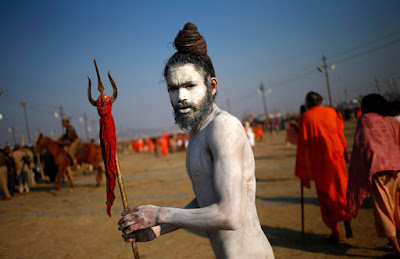Sangam (Allahabad): The Naga sanyasis are perhaps the most photographed and the least understood of ancient Hindu cults. With their nudity, matted hair, ash-smeared bodies, andsmoking chillums, they do not make it any easier for plain rural folk -- to say nothing of urbanised Hindus - to "follow" them, just as they follow the rest of the 13 sects or akharas of Hinduism. The Nagas are forbidding and would not do anything that would help in demystifying them. "Don't mess with us," would be their apt idiom.
The Nagas engage with the world outside only after some careful prodding. And they speak in riddles. One such Naga sadhu on being asked what life meant for him, merely muttered, "Andar bela, baahar bela." That was not so tough to figure after he spoke some more after a longish silence: There's a time and universe within one's self, which has nothing to do with the time that the world follows. And they live by the rules of the universe within.
It's historically agreed that the Naga tradition began when the Adi Shankaracharya (8th century) created them as a Hindu army. The Nagas are the most heavily armed and militant of all Hindu akharas, an until this day their retreats are called 'chhaavni' or armed camps. They hold mock jousts with each other using swords, spears and tridents, and until as late as the 1950s, it wasn't unusual for them to strike to kill some one on issues of honour - even during a Kumbh mela.
With their deep veneration for the Adi Shankaracharya, it's not surprising they still chant, "Shankaram Shankaracharyam Keshavam Badyarayanan/Sutra bhashya kato bande Bhagwate punah punah." This is the Shaivite equivalent of "Dharma samsthapanaarthya sambhavaami yuge yuge". Which, of course, paraphrased in their context would read, "I, that is Shiva, is born in every age to save the world from itself."
Born in Kalady, in Kerala, Shankaracharya is said to have left home at age five and travelled across India to create the Dashnaam Sanyas ashrams primarily out of Giris (mountain sects), Puris (from towns/cities), Saraswatis (priests), Van-Aranyaks (forest hermits), and Sagar (seaside sects). Realising the need of shaastra (knowledge) as well as shastra (weapons), Adi Shankaracharya made shaastra the preserve of the acharyas and shastra the "ornaments" of the Nagas. It was these militant Nagas who were instrumental in "winning back" Hinduism from Buddhism.
Once warriors, what do the Nagas do now? Some of them have formed ramta panch (organisation of wandering monks) and are part of the Dashnam Sanyasi tradition. The Dashnami Nagas move on foot from one Kumbh to another holding Shankaracharya's flag and danka (a kind of drum) covering thousands of villages and say they remain at the forefront of protecting Hinduism. The rest remain as impervious as ever.


No comments:
Post a Comment